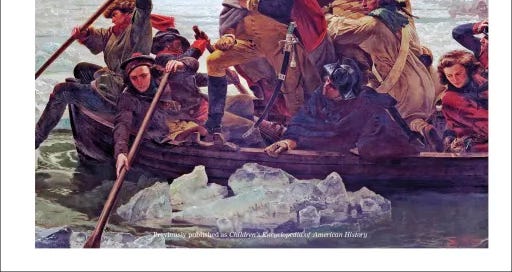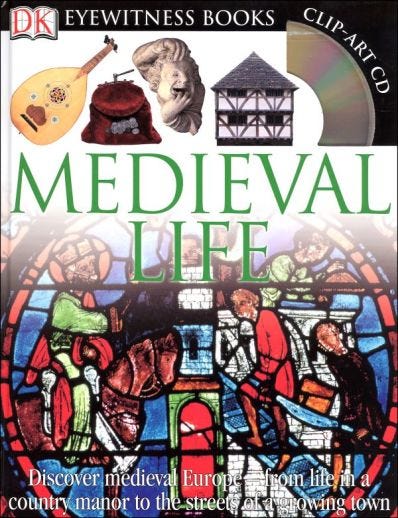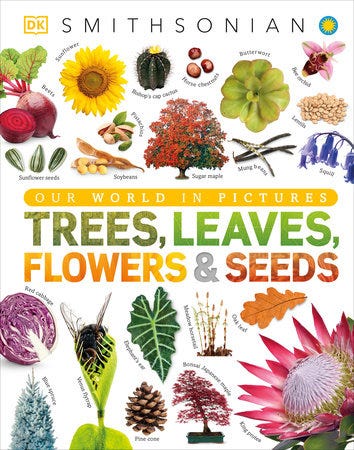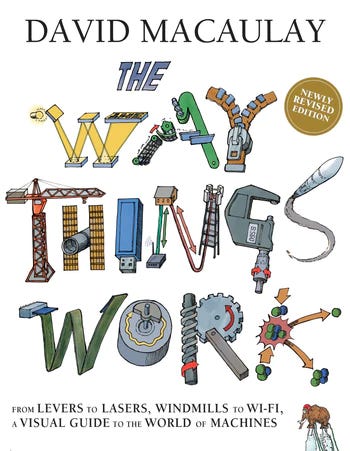Dear Friends,
It can be challenging to find good, basic history and science textbooks for elementary-school-aged children, whether the kids are homeschooled or you’re just looking for something to nourish their interests outside of school hours.
To be clear, this isn’t code for “it’s hard to find textbooks that cater to my particular political tastes.” What I mean is that it can be hard to find textbooks that give good information in attractive, age-appropriate ways without overdoing the ideological spin.
If you are homeschooling, there are of course a million different curricular options out there, and yes, you will find some good ones! And what fits one family may not fit another.
But over time I have found an alternative to textbooks for textbook-like purposes. This alternative category of books is also one that is extremely attractive and motivating to a large majority of children.
Of course, for history, which is my academic specialty, I have thoughts about prioritizing imagination for this age group, which you can read here. (Spoiler alert: it involves crawling backwards through an escape chute in a pyramid. But not everybody has to do that part.) And I do also recommend these pretty balanced textbooks for Catholic kids.
So I’m not a learn-only-by-reading-nonfiction kind of teacher (or learner). But aside from the creative emphases that I outline in the pyramids essay, what has been most successful for me in terms of actually giving children written information about both history and science, in particular, is using a source that may be easy to overlook or otherwise dismiss: I’m talking about visual encyclopedias.
It may be that, whether your are homeschooling, teaching in a school, or just looking for interesting books for your children to explore, you may not have looked closely at the comprehensive richness that such books have to offer. They can be much more than an amusing distraction. They are truly wonderful! I actually once taught an entire-year-long American history class to 4th and 5th graders with this book1 as its core text (supplemented by my lectures and activities and some fiction and poetry, of course):
I used an older version in my class (I think from 2003), but the newer one looks promising, too! (As always, preview the book if you have concerns about children learning prematurely about any particular serious adult topic; history is full of hard things!)
I was astonished (silly me) when I first encountered this book to discover that it is not just a scattered assortment of pretty or interesting pictures with captions, but actually includes really excellent narrative explanations and nuanced analysis of American history appropriate to this age level. I was able to assign 2-3 page spreads each week for the kids to essentially just peruse, and the result was that the kids who were verbally strong and the kids who learned best visually or creatively all benefited.
Just as useful are the wonderful visual encyclopedias available on other periods and topics in history, such as this one on life in the middle ages:
Yes, it is important to know about Charlemagne and Visigoths and all the popes and anti-popes, and you will find some of that in this book, but this is not meaningful to children without context. This kind of book provides that context. What did Visigoths wear? What did they look like? What toys might the very children reading this book have played with in the Middle Ages?
This Middle Ages book (unlike the American history book) is too small to be used as the main “textbook” for a whole year of study, but it’s a great start, and could be used very well in combination with other similar books or fiction and field trips and a timeline.
Children really learn a lot from these books, and what they learn, they have a tendency to retain to a significant degree. I remember poring over a visual encyclopedia on children in Ancient Rome from the Eyewitness series when I was in the 5th grade. I spent hours and hours with it. And I still remember what I learned—I even still have visual memories of some of the drawings and the pages!
Let’s take a look at a science book now:
This book is so much more useful than a textbook that is heavy on text and includes a handful of diagrams. This kind of book feels packed with life, and children are drawn to studying it. There are so many more in this series — animals, the solar system, etc. — to investigate, as well! (In terms of “real” science textbooks, I also have really enjoyed this biology textbook with my kids this year. Also, although I haven’t looked at it closely yet, I bet that the new Beast Academy science books are amazing — their math books are fantastic!!)
In terms of mechanics and that sort of thing, kids are drawn to visual encyclopedias like this one (which has been literally worn to pieces in my house), but of course the cream of the crop is the updated version of The Way Things Work:
And did you know that the Mammoth (see him in the corner, there?) who helps explain everything in this book also has books on math and science? The science one was really helpful in helping my children understand the different states of matter, in particular. There’s also a human anatomy book!
My kids will just sit around looking at these books. Just looking at them and reading bits and pieces from them and taking in their excellent content.
I don’t want to go on too long with actual book recommendations, and you can find many more books like this easily. The point I want to make overall is that not only are these books wonderful academic resources for this age group, but they naturally draw children into studying in a similar way to how just being in the woods draws children toward observation. These books help bridge the gap between picture books and the sustained non-fiction reading that will be necessary in later years as they delve more deeply into these subjects.
Children may certainly be assigned to read pages X through Y in these books, as I did for my class, and that is effective, but they also are simply drawn to sitting there, the book spread open on their lap or the table in front of them (probably beside a bowl of Cheetos or something, yuck) and just looking at the book. They look at the pictures, they read the explanations, they flip back and forth.
They study. On their own. Because they want to. Because it’s interesting. So not only are they absorbing good content, but they are learning to study in the best way—as a response to curiosity.
And so, they grow.
What do you think?
Have a wonderful week!
As always, these are not affiliate links.








We were gifted several sets of Usborne visual encyclopedias and my kids will sit there and just read them for fun 😆. We also have had good luck with the other more specific Usborne books like Medieval World and the Encylopedia of World History.
These are really appropriate for probably middle school and up, but I remember using Joy Hakim’s Story of US series for US History and the visual encyclopedia style was much more engaging than a normal textbook.
(My kids also are obsessed with any animal encyclopedias we find — Dinopedia is a library favorite 😝)
THE WAY THINGS WORK!
Our boys (mind you, 4 and almost 3 years old) became obsessed with it when they saw it at my parent's house.... and so they bought us a copy a while back. haha